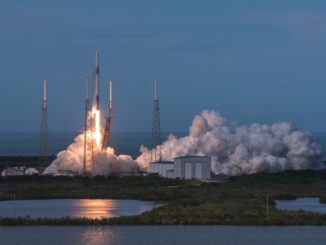
The next flight of an Ariane 5 rocket, previously set for next week, has been delayed to no earlier than July 30 to review the readiness components it has in common with the Vega rocket after a launch failure earlier this month.
Two officials familiar with the launch planning said investigators probing the July 10 failure of a light-class Vega rocket minutes after liftoff from French Guiana want to ensure parts on the larger Ariane 5 rocket are ready to fly.
The solid-fueled Vega rocket’s climb into orbit from the Guiana Space Center on July 10 went awry around two minutes after liftoff, moments after the planned ignition of the Vega’s Zefiro 23 second stage motor.
Officials have not announced any results from the Vega failure investigation, which is co-chaired by the European Space Agency’s inspector general and Arianespace’s vice president responsible for technical and quality issues.
Arianespace, the French launch services provider, is the commercial company in charge of Ariane 5, Soyuz and Vega launch operations at the Guiana Space Center, a tropical spaceport located on the northeastern coast of South America.
ESA supports the development of European satellite launchers, including Vega, and helps oversee the Guiana Space Center in partnership with CNES, the French space agency.
The prime contractor for the Vega rocket is Avio, an Italian aerospace company, which builds solid-fueled motors for the Vega rocket at a factory in Colleferro, near Rome. Avio also has a major share in production of the Ariane 5’s twin solid rocket boosters.

Officials said the day after the Vega launch failure that preparations for the next Ariane 5 rocket flight, then set for July 24, were proceeding as planned.
But sources said Friday that the Ariane 5 launch has been delayed to no earlier than July 30, and could face additional schedule slips to ensure the Ariane 5 is free of the fault that caused the Vega accident.
The July 10 mishap marked the first failure for the Vega rocket after 14 straight successful launches since its debut in February 2012. The Falcon Eye 1 military reconnaissance satellite for the United Arab Emirates was destroyed in the launch failure as the Vega rocket fell into the Atlantic Ocean north of French Guiana.
The Ariane 5 rocket now set for liftoff no earlier than July 30 will carry two communication satellites to geostationary transfer orbit.
The largest of the two communication payloads waiting launch on the Ariane 5 rocket, named Intelsat 39, will replace the Intelsat 902 spacecraft launched by an Ariane 4 rocket in August 2001. Intelsat will use the new satellite, built by Maxar in Palo Alto, California, will provide broadband and video services across Africa, Europe, the Middle East and Asia.
Intelsat 39’s co-passenger will be the first dedicated satellite for the European Data Relay System, a network developed by the European Space Agency and Airbus Defense and Space providing high-speed laser communications links between low-orbiting satellites and ground stations.
The EDRS-C spacecraft, built in Germany by OHB System AG, also carries a hosted steerable Ka-band payload named Hylas 3 for Avanti Communications to provide services over Africa.
Email the author.
Follow Stephen Clark on Twitter: @StephenClark1.



